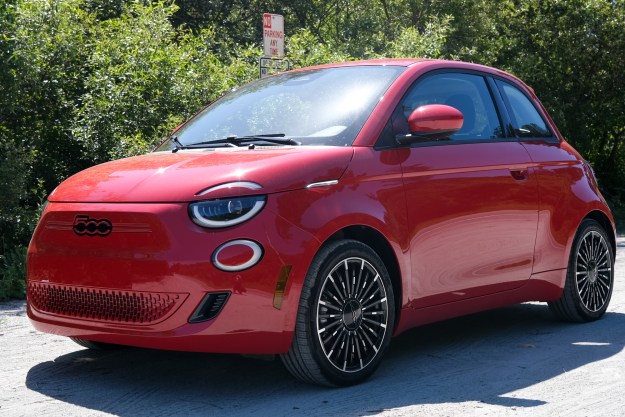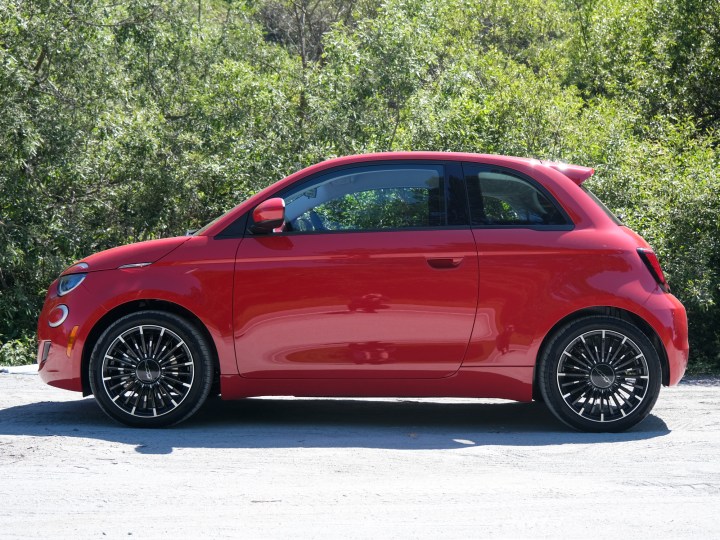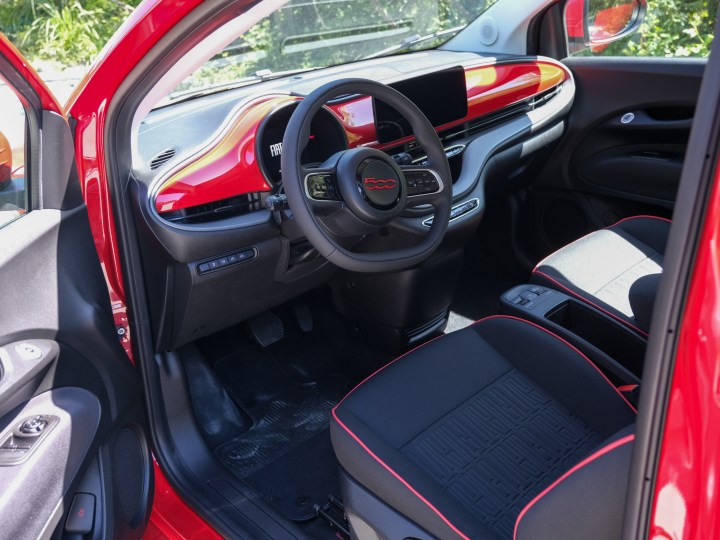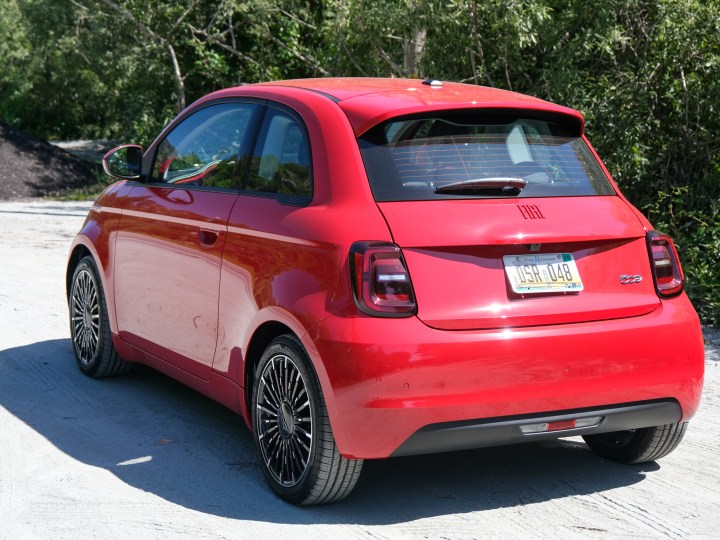
“If you regularly drive longer distances, then the Fiat 500e is probably better suited as a second car, rather than a primary one.”
- Fun design
- Comes with Level 2 charger
- Comfortable front seats
- Cramped second row
- Limited range
- Slow charging
The U.S.A. is the land of big cars. Trucks, SUVs, and crossovers are by far more popular than sedans and smaller cars. That’s not necessarily all that surprising — while in some countries you might rely a little more on trains or public transportation, in the U.S., you pretty much have to drive to get anywhere. And, considering how much we drive and the distances we drive, it makes sense to want something a little roomier. But Fiat thinks that can change — and that there’s a market for smaller, so-called city cars in North America. To that end, it’s bringing the 2024 Fiat 500e stateside.
The Fiat 500e isn’t just small, though — it’s also cheap. Or, at least it’s cheaper than the average EV, with a starting price of $32,500.
I can see the appeal of a car like this. Sure, it may not be everyone’s primary car — but the U.S. isn’t just the land of big cars, it’s the land of multiple cars, at least in a household of two or more adults. Does the Fiat 500e do enough to justify its presence in North America? I’ve been driving the Fiat 500e Inspi(Red) for the past week to find out.
Design and interior
Just saying the Fiat 500e is small doesn’t really do it justice, and I was surprised at just how tiny it was when I first saw it in person. Technically, it’s a four-seater, with a second row of seats that can be accessed by crawling through one of the two doors.
The 500e isn’t necessarily the most stylish car, but it’s certainly cute. But it’s not as cute as a Mini, for example. Mini sells the Mini Electric Hardtop in a similar price range to the 500e, and if we’re talking pure looks, I have to say that the Mini has the edge. Whether or not it’s a good EV is another question, of course.
The 500e has a rounded roofline and a hatchback that hides a relatively tiny trunk. With the second-row seats up, you’ll get 9.5 cubic-feet of space, however you could treat the car like a two-seater and put the rear seats down to get 30.1 cubic-feet of space. Alternatively, you can just put one rear seat down, if you want, to split the difference.

That second row, of course, isn’t necessarily comfortable. In fact, it’s downright cramped. But it’s nice that there’s a second row at all, and to be clear, you shouldn’t buy this car as a family driver, but rather use the rear seats in a pinch for shorter trips.
At the front of the car, you’ll find two semicircle headlights with a large “500” logo, sitting atop a lower grille for air intake. It has a very short nose, but that kind of fits the car.

If you’re sitting in the front seats, the car is relatively comfortable. You’d be hard-pressed to call it very “premium,” but this isn’t meant to be a luxury car. Still, I was pleasantly surprised to find a nice stitched leather on the seats that sport a black-and-red color scheme. It looks good, and feels nice too, and the seats were comfortable for the kinds of short drives I took with it.
Tech, infotainment, and driver assist
At the front of the car, you’ll find a 10.2-inch infotainment display, and it comes with Fiat’s own infotainment system. The software wasn’t my favorite. As expected from a legacy automaker, it was slow to respond and a little confusing to navigate.

Thankfully, the car supports Android Auto and Apple CarPlay through a wireless connection, so you can mostly avoid having to use Fiat’s software.
The Fiat 500e has options for a number of basic driver-assist features, however our model didn’t have many. The Inspi(Red) model we tested is the base 500e for 2024, and it lacks features like adaptive cruise control and lane-centering — which are available on the two more expensive models (called “Inspired by Music” and “Inspired by Beauty”). Our model instead only really had a basic cruise control (not adaptive).
Driving experience
The experience of driving the Fiat 500e is more or less what you might expect. It’s not built to be ultrafast, however, it is pretty nimble, and steering is relatively responsive. It’s a small car, and it feels like one when you drive it.
There are some things that really bother me about driving the 500e. For example, when you enter the car, put your foot on the brake, and press the on button, it only turns on the accessories. You have to do so again and then put the car into drive to start driving. Also, I found the mode switcher to be very unresponsive — clicking the dial for drive modes worked less than half the time, which was very frustrating.

The car has three drive mode s– Normal, Range, and Sherpa. The three modes revolve around range preservation rather than performance, with Sherpa preserving the most range by limiting performance. If you truly use this car as a city car, and can charge at home, it might be worth simply keeping it in Normal mode, but I still found driving Sherpa mode to be perfectly fine.
For the most part, of course, you’ll get used to the quirks of driving the car, and when you do, you’ll find driving it to be a relatively good experience. Again, it’s not the fastest EV out there, but it is mostly responsive, both in terms of acceleration and steering.
Range and charging
One of the main downsides to a car like this comes in the form of range. The Fiat 500e is built for short trips and regular charging. To that end, it only offers a range of around 150 miles, according to Fiat. The Envornmental Protection Agency (EPA) has yet to rate the car, however, that range estimate seemed about right in my testing.

Of course, 150 miles isn’t great when most high-end EVs these days offer a range of up to around 300 miles. But again, this car isn’t built to be a road-tripper. It’s built for around-town driving, possibly as a second car, with regular charging at home, where possible.
Speaking of charging, it’s not all that quick. The car can be charged at up to a speed of 85 kilowatts at a DC fast charger, with Fiat saying it will add 31 miles of range in around five minutes. However, Fiat is actually selling the car with Level 2 chargers that buyers will be able to have installed in their garage by an electrician — helping make it easier to swallow the pill of a lower range. The Level 2 charger should fully charge the car in around six hours — so if you plug it in overnight, it’ll be ready to go in the morning, no matter how much you used it the night before. That’s not bad.
How DT would configure this car
The Fiat 500e has a lot going for it, but you have to manage expectations. There are a few situations where you might like a Fiat 500e. If you’re looking for a car you can drive around town, and you have the ability to charge at home, it’s a solid option. If you regularly drive longer distances, then the Fiat 500e is probably better suited as a second car, rather than a primary one.
If you are interested in the 500e, the base model isn’t a bad option, especially considering the fact that the different trims don’t add more range or faster charging. However, the two higher-end of the three models do add advanced features like adaptive cruise control and lane-centering, which can be helpful. We would recommend sticking to the base model purely for saving money — but again, some peoplemight want to upgrade.
It’s worth considering alternatives too. The Mini Electric Hardtop is a better-looking car, but it has an even lower range, and you won’t get a Level 2 charger with it. If you’re concerned about range in a small car like this, the 500e is a better option — but if you prefer to drive in style, perhaps it’s worth considering the even-cheaper Mini. The other big alternative in the U.S. is the Bolt EV, which is much cheaper, but offers a better range and faster charging. It is, of course, much less interesting to look at — but if you’re looking for a car that performs well as an EV, it’s probably the best option of all of them.
Editors' Recommendations
- Fiat delivers jolt of color, creativity with Panda-inspired concept electric vehicles
- Fiat’s 500e returns as a stylish and affordable small EV
- 2022 Audi e-tron GT first drive review: This slot car needs no track
- Audi E-Tron vs. Jaguar I-Pace
- Check out the awesome acoustic alert on the new Fiat 500 EV


